【VIP专享】第七章_销售
《新品上市完全手册》第七章新产品上市促销执行及控制要点

《新品上市完全手册》第七章新产品上市促销执行及控制要点促销,顾名思义,促进销售的方法。
本品一个额外的理由”之本意,专门是新产品上市,几乎所有的工作环节都牵涉促销。
做促销不是拍广告片,各企业促销手法雷同,谁也玩不出什么创意和花样来。
决定企业促销成效要紧因素有两个:·促销做的到位:对一个促销活动各环节工作的细致布置和切实执行。
第一节通路促销新品上市,通路进货、铺货是销售工作的起点。
如何能够使通路中商户们心甘情愿的进货,并出让他们仅有的柜台空间,摆放新品,通路促销是一个有力的武器。
新品上市可采纳的通路促销手法为:1.经销商新品订货会2.经销商价格折扣促销3.经销商销售竞赛4.批发商进货搭赠5.批发商订货会6.批市陈设奖励7.零店铺货奖励8.随箱附赠刮刮卡9.箱皮回收10.零店陈设奖励通路促销的执行单位通常是企业销售部门。
以下将分别探讨新品上市各种常用通路促销的执行细节和操纵要点。
(一)经销商新品订货会活动内容简述:邀请全部的经销商参会,通过新品的演示介绍,现场订购的优待政策,鼓舞经销商主动主动在大会现场订购新品的会议促销方式。
活动适用范畴:新品上市要求迅速铺进经销商网络,营造全面上市气氛。
取得大量订单,迅速回笼资金。
由于新品上市订货会费用较大,一样用于战略性新产品的上市。
活动方案撰写要点:1、订货会实施方案的一样步骤。
1)确定经销商参会人数。
按照上市范畴锁定参会经销商人数,以备后续订房、订餐位等一系列工作。
2)确定会议议程,如会议议程包括:签到时刻、大会开始、领导致辞、产品介绍演示、观看广告片、参观新品展现、宴会、订货、订货结果宣布、订货状元评奖、文娱节目、会议终止时刻、撤离酒店时刻等。
3)确定费用预算。
费用预算的要紧开支项目:会务费(包括住宿、宴会、会场租金、设备租金、娱乐项目费用等);经销商路费、现场布置费用(展台布置、展板制作、大型喷绘、产品陈设架制作,彩旗、条幅、升空气球租金等);媒体报导费用(邀请电视台、电台、报纸人员费用、录制制作费、播出费、刊登费、礼品等);临时人员劳务费;其它费用。
客户vip等级管理制度
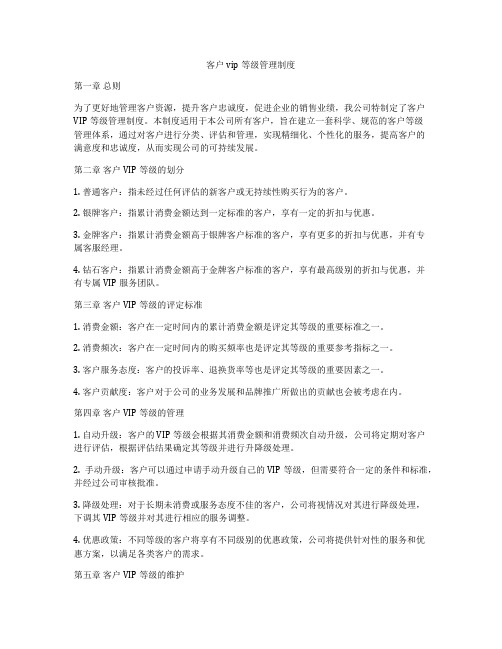
客户vip等级管理制度第一章总则为了更好地管理客户资源,提升客户忠诚度,促进企业的销售业绩,我公司特制定了客户VIP等级管理制度。
本制度适用于本公司所有客户,旨在建立一套科学、规范的客户等级管理体系,通过对客户进行分类、评估和管理,实现精细化、个性化的服务,提高客户的满意度和忠诚度,从而实现公司的可持续发展。
第二章客户VIP等级的划分1. 普通客户:指未经过任何评估的新客户或无持续性购买行为的客户。
2. 银牌客户:指累计消费金额达到一定标准的客户,享有一定的折扣与优惠。
3. 金牌客户:指累计消费金额高于银牌客户标准的客户,享有更多的折扣与优惠,并有专属客服经理。
4. 钻石客户:指累计消费金额高于金牌客户标准的客户,享有最高级别的折扣与优惠,并有专属VIP服务团队。
第三章客户VIP等级的评定标准1. 消费金额:客户在一定时间内的累计消费金额是评定其等级的重要标准之一。
2. 消费频次:客户在一定时间内的购买频率也是评定其等级的重要参考指标之一。
3. 客户服务态度:客户的投诉率、退换货率等也是评定其等级的重要因素之一。
4. 客户贡献度:客户对于公司的业务发展和品牌推广所做出的贡献也会被考虑在内。
第四章客户VIP等级的管理1. 自动升级:客户的VIP等级会根据其消费金额和消费频次自动升级,公司将定期对客户进行评估,根据评估结果确定其等级并进行升降级处理。
2. 手动升级:客户可以通过申请手动升级自己的VIP等级,但需要符合一定的条件和标准,并经过公司审核批准。
3. 降级处理:对于长期未消费或服务态度不佳的客户,公司将视情况对其进行降级处理,下调其VIP等级并对其进行相应的服务调整。
4. 优惠政策:不同等级的客户将享有不同级别的优惠政策,公司将提供针对性的服务和优惠方案,以满足各类客户的需求。
第五章客户VIP等级的维护1. 定期沟通:公司将定期与客户进行沟通和交流,了解客户的需求和意见,提供个性化的服务和解决方案。
4s店销售群管理制度
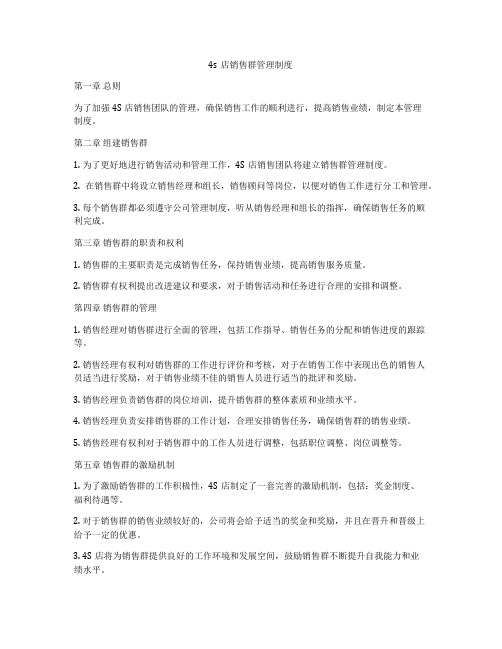
4s店销售群管理制度第一章总则为了加强4S店销售团队的管理,确保销售工作的顺利进行,提高销售业绩,制定本管理制度。
第二章组建销售群1. 为了更好地进行销售活动和管理工作,4S店销售团队将建立销售群管理制度。
2. 在销售群中将设立销售经理和组长,销售顾问等岗位,以便对销售工作进行分工和管理。
3. 每个销售群都必须遵守公司管理制度,听从销售经理和组长的指挥,确保销售任务的顺利完成。
第三章销售群的职责和权利1. 销售群的主要职责是完成销售任务,保持销售业绩,提高销售服务质量。
2. 销售群有权利提出改进建议和要求,对于销售活动和任务进行合理的安排和调整。
第四章销售群的管理1. 销售经理对销售群进行全面的管理,包括工作指导、销售任务的分配和销售进度的跟踪等。
2. 销售经理有权利对销售群的工作进行评价和考核,对于在销售工作中表现出色的销售人员适当进行奖励,对于销售业绩不佳的销售人员进行适当的批评和奖励。
3. 销售经理负责销售群的岗位培训,提升销售群的整体素质和业绩水平。
4. 销售经理负责安排销售群的工作计划,合理安排销售任务,确保销售群的销售业绩。
5. 销售经理有权利对于销售群中的工作人员进行调整,包括职位调整、岗位调整等。
第五章销售群的激励机制1. 为了激励销售群的工作积极性,4S店制定了一套完善的激励机制,包括:奖金制度、福利待遇等。
2. 对于销售群的销售业绩较好的,公司将会给予适当的奖金和奖励,并且在晋升和晋级上给予一定的优惠。
3. 4S店将为销售群提供良好的工作环境和发展空间,鼓励销售群不断提升自我能力和业绩水平。
第六章销售群的培训和考核1. 为了提高销售群的整体素质,4S店将定期对销售群进行销售技巧和产品知识的培训,提高销售群的综合素质和业绩水平。
2. 销售群将定期进行销售业绩的考核,对于业绩良好的销售群和销售人员进行适当的奖励和激励措施,以及对于业绩不佳的销售群和人员进行适当的整改和辅导。
第七章销售群的沟通和协作1. 为了更好地进行销售活动和管理工作,销售群必须积极配合和沟通,确保销售任务的顺利完成。
完整的销售宝典ppt课件

2024/7/19
探寻客户需求的方法(询问)
用开放无指向问题去获取无偏见的资料 用开放有指向问题能发掘更深 封闭型问题去达到精简要求
2024/7/19
缩小范围,得出需求
探寻客户需求的方法(聆听)
• 销售人员要了解产品,能够用最简单的语 言明确介绍产品的最重要特点。
2024/7/19
挖掘产品的卖点
• 产品介绍不能泛泛而谈,要抓住最有利于 销售的关键点进行介绍
• 卖点:是产品所具有的,销售人员阐述的, 与客户需求联系最密切,对客户的购买决 定最具影响力的因素。
• 卖点的分类
– 基本卖点 – 附加卖点
2024/7/19
错误的观念和做法
• 客户自便 • 心里顾忌,害怕客户反感 • 错误的建议购买
2024/7/19
识别购买信号的识别
• 购买信号就是用身体和声音表现满意的形 式。
– 语言 – 身体语言
2024/7/19
如何建议购买
• 询问客户还有无其他要求 • 建议购买的技巧 • 不要催促客户
2024/7/19
• 让客户喜欢上你,创造良好的开端。 • 开场白是一次销售的前奏,开场白是否具
备必要的技巧是一个销售人员专业与否的 重要标志。 • 主动询问、切入式、应答式和迂回式开场 白是目前卖场的环境中常用的几种方式, 可以根据实际情况灵活运用。 • 注意接近客户的“火候”与时机。
2024/7/19
第二:探寻客户需求
• 客户讲话时候不要打断
• 适时给客户适当的鼓励和恭维
• 努力记住客户的话
• 若有不清楚的地方最好有礼貌地请客户再
中国建设银行结算通业务操作规程【VIP专享】

中国建设银行个体工商户资金结算系统(结算通)业务操作规程中国建设银行个人金融部二零零七年十月三十日中国建设银行结算通业务操作规程目录:第一章总则第二章开销户业务处理第三章功能维护第四章交易处理第五章信用额度第六章特殊业务处理第七章附则第一章总则第一条为加强结算通业务管理,规范结算通业务操作,根据《中国建设银行结算通业务管理办法(试行)》及个人金融业务有关规章制度,制定本操作规程。
第二条本操作规程所称结算通业务,是指以结算通卡为载体,为客户提供现金存取、转账、汇款、消费等业务功能的基础上,还可为客户提供关联客户管理、灵活付费、客户等级管理、透支、差别化服务、商机建议及“交易资金托管”等特色服务的个人人民币支付结算业务。
第三条本规程适用于开办结算通业务的机构及人员。
第二章开销户业务处理第四条开户申请一、操作流程1.年满18周岁以上,具有完全民事行为能力且符合条件的自然人,即可申请办理结算通业务;结算通开户执行实名制规定。
2.客户将身份证原件和复印件交柜员审核,客户身份证件复印件留存备查。
3.客户本人需填写《结算通卡申请表》,填写要素包括:申请日期、户名、单位、家庭住址、联系方式(住宅电话、办公电话和手机号码)、寄送对账单地址、邮政编码等。
4.柜员应提示客户认真阅读“结算通客户服务协议”内容,并请客户在“结算通卡申请表”上签字确认。
5.经办人员对客户提交的申请资料进行审核,审核内容包括:1)申请资料填写内容是否完整;2)对申请人证件的真实性进行核实;3)服务协议上客户签字是否有效;6.柜员审核无误后,将资料录入系统,当录入身份证件号时,系统将已存在资料进行反显,如没有反显,柜员必须录入相关信息,系统返回相关的客户信息,柜员进行人工判别选定后确认提交。
7.柜员审核有关凭证无误后,将系统打印的“卡申请回执”一式两联,交客户签字确认。
柜员收回“卡申请回执”,审核无误后,加盖业务用章和个人名章,一联卡申请回执交客户留存,一联卡申请回执装订在当日会计凭证中。
服装销售针对Vip工作计划

服装销售针对Vip工作计划第一章:引言1.1 介绍在当今竞争激烈的市场环境中,为了有竞争力和增加利润,服装企业不得不朝着针对VIP 客户的销售策略发展。
VIP客户拥有更高的购买力和消费需求,他们对品质和服务有更高的要求,因此,将VIP客户作为一个独立的销售群体进行营销策略的制定势在必行。
1.2 目的本文旨在制定一份有效的服装销售VIP工作计划,以提高对VIP客户的销售和服务水平,增加销售额和客户满意度。
第二章:市场分析2.1 客户分析对VIP客户进行细分和分类,了解他们的需求、喜好、购买习惯以及所处的社会地位等,以便更好地为他们提供个性化的销售和服务。
VIP客户主要包括有高消费能力的个人、企业及组织等,他们对时尚、品质和个性化需求较为突出。
2.2 竞争分析分析竞争对手的VIP销售策略、产品定位、价格策略、服务质量等方面,并制定相应的对策,确保能够在激烈的竞争环境中获得优势。
第三章:工作目标3.1 销售目标根据市场分析结果、公司战略目标和VIP客户需求,设定年度、季度和月度的销售目标。
同时,为VIP客户制定个性化的销售目标,并跟踪评估达成程度。
3.2 客户满意度目标将VIP客户满意度作为一个关键绩效指标,设定具体的满意度目标,并通过客户调研和反馈收集客户满意度信息,不断优化销售和服务流程。
第四章:销售策略及方案4.1 产品定位通过了解VIP客户需求和市场趋势,进行产品定位,以提供符合VIP客户口味和需求的服装款式、材质和设计。
4.2 价格策略制定差异化的价格策略,通过VIP价目表、折扣策略、积分兑换等方式,吸引VIP客户并提高他们的忠诚度。
4.3 服务质量制定一套专属的VIP客户服务流程,包括个性化咨询、试衣、送货上门、免费改衣等服务,提高VIP客户购物体验和满意度。
4.4 客户关系管理建立VIP客户数据库,定期和定向地开展客户关怀活动,包括生日礼品、节日问候、限量商品预售等,增强客户的归属感和忠诚度。
第7章 现金流量表分析习题【VIP专享】
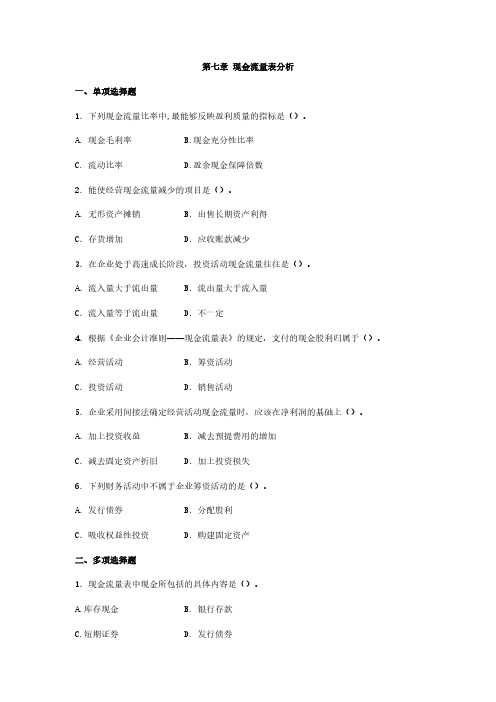
第七章现金流量表分析一、单项选择题 1.下列现金流量比率中,最能够反映盈利质量的指标是()。
A. 现金毛利率B.现金充分性比率C. 流动比率D.盈余现金保障倍数2.能使经营现金流量减少的项目是()。
A.无形资产摊销 B.出售长期资产利得C.存货增加 D.应收账款减少3.在企业处于高速成长阶段,投资活动现金流量往往是()。
A.流入量大于流出量 B.流出量大于流入量C.流入量等于流出量 D.不一定4.根据《企业会计准则——现金流量表》的规定,支付的现金股利归属于()。
A.经营活动 B.筹资活动C.投资活动 D.销售活动5.企业采用间接法确定经营活动现金流量时,应该在净利润的基础上()。
A.加上投资收益 B.减去预提费用的增加C.减去固定资产折旧 D.加上投资损失6.下列财务活动中不属于企业筹资活动的是()。
A.发行债券 B.分配股利C.吸收权益性投资 D.购建固定资产二、多项选择题1.现金流量表中现金所包括的具体内容是()。
A.库存现金B. 银行存款C.短期证券D. 发行债券2.属于筹资活动现金流量的项目有()。
A.短期借款增加 B.资本净增加C.增加长期投资 D.偿还长期债券E.取得债券利息收入收到的现金3.从净利润调整为经营活动现金流量,应调增的项目有()。
A.流动负债减少 B.财务费用C.不减少现金费用 D.非流动资产增加E.投资损失4.下列活动中,属于经营活动产生的现金流量有()。
A.销售商品收到的现金B.分配股利支出的现金C.提供劳务收到的现金D.出售设备收到的现金E.交纳税款支出的银行存款5. 从经营活动现金流量调整为净利润,应调减的项目有()。
A.流动负债减少 B.投资损失C.不减少现金费用 D.非现金流动资产的减少E.固定资产折旧6.属于筹资活动现金流量的项目有( )。
A.短期借款的增加B.支付给职工的现金C. 或有收益D.分配股利所支付的现金E. 取得债券利息收入7.下列项目中,属于现金流入项目的有()。
客户沟通技巧第七章

7.4.6 用心服务客户
作为营业人员,要真正地用心为客户提供服务,用心 思考,善于总结,真诚地为客户服务;对客户要将心比 心,学会换位思考,多站在客户的角度去考虑,善于抓 住客户的心理进行“攻略”。
客户沟通技巧
第七章 客户需求分析
销售是98%的了解人性+2%的产品知识
7.1 客户需要什么
因为销售渠道越来越多,商品让人眼花缭乱, 客户的选择也多了,所以,很多店面的销售人员 抱怨现在的客户越来遇难伺候了。
店面销售人员可以为客户做什么? 客户的真正需求是什么? 这些都是我们需要思考的问题。
7.1 客户需要什么
如果没有得到回答,还应该继续问一些其他的问题,从而确认 问题是所在。
常规式
常规式是指一般在与客户交谈时,可以问一些了解客户 身份的问题。
例如:“先生,您怎么称呼?”“137XXXXX023是你的 号码吗?”
客户的姓名、电话号码等都应该掌握,其目的是获得客 户的个人信息,从而拉近与客户的距离,也便于售后服务 或通知老客户参加周年庆等回馈活动。
作为一位销售人员,还必须了解客户内心真 正需要的是什么,他们的心理需求是什么。这些 可以通过客户的“穿着打扮、举止神态、语言修 饰”方面来判断客户的特征以及识别其需求。
7.3.1 通过提问了解客户的需求
用封闭式问题来提问,通常得到的都是明确的答案, 类似“是”或者“不是”或一点详细的信息。如果营业 员需要了解一些数据指标的话,它们是非常有用的。 例如:“您想买一对钻石结婚对戒吗?”“您喜欢这个 款式吗?” 但是,这类问题很有可能会引发谈话中断,然后被迫尴 尬地进入下一个话题,如“请问您是看黄金首饰吗?”
2020中级会计财管第七章

配融资
融资方式(负债或权益)来融通,波动性流动资产用短期来源融 险居
策略
通。
中
短期来源=波动性流动资产
长期来源=永久性流动Байду номын сангаас产+非流动资产
25
【提示】资金来源的有效期与资产的有效期的匹配,只是一种战 略性的观念匹配,而不要求实际金额完全匹配。实际上,企业也做不 到完全匹配。 其原因是:
(1)企业不可能为每 一项资产按其有效期 配置单独的资金来源, 只能分为短期来源和 长期来源两大类来统 筹安排筹资。
39
【例·判断题】企业之所以持有一定数量的现金,主要是出于交易需求、 预防需求和投机需求。( )
【答案】√ 【解析】企业持有现金是出于三种需求:交易性需求、预防性需求和投 机性需求。
40
【例·多选题】下列各项中,决定预防性现金需求数额的因素有( )。 A.企业临时融资的能力 B.企业预测现金收支的可靠性 C.金融市场上的投资机会 D.企业愿意承担短缺风险的程度
A.该企业采取的是激进融资战略 B.该企业采取的是保守融资战略 C.该企业收益和风险均较高 D.该企业收益和风险均较低
32
【答案】BD 【解析】波动性流动资产=100-30=70(万元),短期融资50万元, 短期融资只解决了一部分波动性流动资产,另外一部分波动性流动资产 需要通过长期资金来源解决,这种情况属于长资短用,因此,属于保守 融资战略。保守融资战略的特点是收益和风险均较低。
预防 需求
企 现 事业金件需,(大要以客维应户持付违充突约足发)。持(((123)))有企企企现业业业金愿 预 临额冒 时测的现 融现多金 资金少短 的收取缺 能支决风 力可于险 。靠:的的程程度度;;
投机 需求
第07章目标市场营销战略
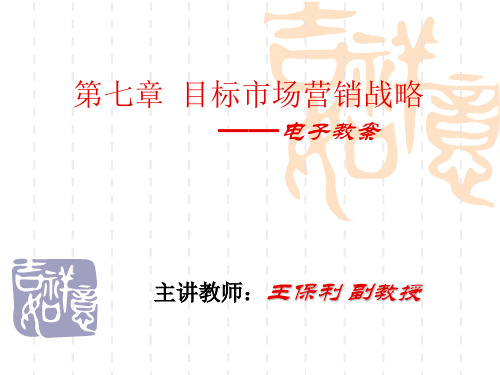
市场细分可使企业集中力 量、发挥优势
▪ 市场细分使目标顾客更明确。 ▪ 市场细分,使企业营销策略的制和实施
更有针对性,因此,效益更加显著。 ▪ 市场细分,使信息反馈更加迅速
细分市场要足够大,使企业有相当的 销售量。
4、细分市场的程序
对某一特定市场进行细分,一般要经过三个步 骤:
营销学者温德尔·斯密于二十世纪50年代提出的一个概念。 ▪ 市场细分,就是针对顾客需求和购买行为的差异性,把
顾客分成若干个顾客群,同一顾客群内的顾客需求相同或 相似,而不同顾客群之间的需求具有明显或较大的差异。 每一顾客群,由于其需求相似,可以看成一个单独的小市 场,称为细分市场。不同的顾客群,由于需求的差异性, 可以看成不同的细分市场 。
根据分析中的主要不同特征,命名细分市场,由 于细分市场是不断变化的,故市场划分的程序必 须定期反复进行。
二、细分消费者市场的依据。
1、地理细分
4、行为细分
2、人口细分 3、心理细分
消费者市场细分的主要变量
地理因素
地区、规模、 人口密度、气候
心理因素
生活方式、个性
人文统计
年龄、性别、家庭、收入、 职业、教育、种族、代沟、
儿童
薄荷爱好 者
喜好享受 者
品牌C、D
三、工业细分市场的依据
1、工业品需求与购买特点 (1)工业品需求是派生的需求,即工业品 购买是为了再生产。 (2)工业品需求缺乏弹性,不会因为价格 变化而改变需求量。
(3)工业品购买的理智性,是知识性购买、 行家的购买。
(4)工业品购买批量大,买卖双方的依赖性 也大。
基本市场偏好模式
(a) 同质偏好
现代物流-英文版测试题-第七章需求管理、订单管理
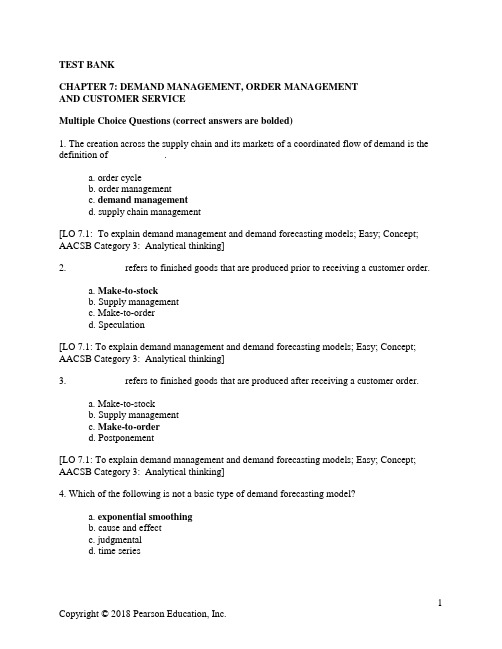
TEST BANKCHAPTER 7: DEMAND MANAGEMENT, ORDER MANAGEMENTAND CUSTOMER SERVICEMultiple Choice Questions (correct answers are bolded)1. The creation across the supply chain and its markets of a coordinated flow of demand is the definition of ___________.a. order cycleb. order managementc. demand managementd. supply chain management[LO 7.1: To explain demand management and demand forecasting models; Easy; Concept; AACSB Category 3: Analytical thinking]2. ___________ refers to finished goods that are produced prior to receiving a customer order.a. Make-to-stockb. Supply managementc. Make-to-orderd. Speculation[LO 7.1: To explain demand management and demand forecasting models; Easy; Concept; AACSB Category 3: Analytical thinking]3. ___________ refers to finished goods that are produced after receiving a customer order.a. Make-to-stockb. Supply managementc. Make-to-orderd. Postponement[LO 7.1: To explain demand management and demand forecasting models; Easy; Concept; AACSB Category 3: Analytical thinking]4. Which of the following is not a basic type of demand forecasting model?a. exponential smoothingb. cause and effectc. judgmentald. time series[LO 7.1: To explain demand management and demand forecasting models; Moderate; Synthesis; AACSB Category 3: Analytical thinking]5. Surveys and analog techniques are examples of ___________ forecasting.a. cause and effectb. time seriesc. exponential smoothingd. judgmental[LO 7.1: To explain demand management and demand forecasting models; Moderate; Application; AACSB Category 3: Analytical thinking]6. An underlying assumption of ___________ forecasting is that future demand is dependent on past demand.a. trial and errorb. time seriesc. judgmentald. cause and effect[LO 7.1: To explain demand management and demand forecasting models; Moderate; Concept; AACSB Category 3: Analytical thinking]7. Which forecasting technique assumes that one or more factors are related to demand and that this relationship can be used to estimate future demand?a. exponential smoothingb. judgmentalc. cause and effectd. time series[LO 7.1: To explain demand management and demand forecasting models; Moderate; Concept; AACSB Category 3: Analytical thinking]8. Which forecasting technique tends to be appropriate when there is little or no historical data?a. exponential smoothingb. judgmentalc. time seriesd. cause and effect[LO 7.1: To explain demand management and demand forecasting models; Moderate; Application; AACSB Category 3: Analytical thinking]9. ___________ suggests that supply chain partners will be working from a collectively agreed-to single demand forecast number as opposed to each member working off its own demand forecast projection.a. Supply chain orientationb. Collaborative planning, forecasting, and replenishment (CPFR) conceptc. Order managementd. Supply chain analytics[LO 7.1: To explain demand management and demand forecasting models; Easy; Concept; AACSB Category 3: Analytical thinking]10. ___________ refers to the management of various activities associated with the order cycle.a. Logisticsb. Order processingc. Demand managementd. Order management[LO 7.2: To examine the order cycle and its four components; Easy; Concept; AACSB Category3: Analytical thinking]11. The order cycle is ___________.a. the time that it takes for a check to clearb. the time that it takes from when a customer places an order until the selling firm receives the orderc. also called the replenishment cycled. also called the vendor cycle[LO 7.2: To examine the order cycle and its four components; Moderate; Concept; AACSB Category3: Analytical thinking]12. The order cycle is composed of each of the following except:a. order retrieval.b. order delivery.c. order picking and assembly.d. order transmittal.[LO 7.2: To examine the order cycle and its four components; Difficult; Synthesis; AACSB Category 3: Analytical thinking]13. Which of the following statements is false?a. Some organizations have expanded the order management concept to include the length of time it takes for an organization to receive payment for an order.b. The order cycle should be analyzed in terms of total cycle time and cycle time variability.c. Order management has been profoundly impacted by advances in information systems.d. Order management is synonymous with order cycle.[LO 7.2: To examine the order cycle and its four components; Difficult; Synthesis; AACSB Category 3: Analytical thinking]14. Order transmittal is ___________.a. the series of events that occurs from the time a customer places an order and the time the customer receives the orderb. the series of events that occurs between the time a customer places an order and the time the seller receives the orderc. the series of events that occurs between the time a customer perceives the need for a product and the time the seller receives the orderd. the series of events that occurs between the time a customer places an order and the time the order cycle begins[LO 7.2: To examine the order cycle and its four components; Moderate; Concept; AACSB Category 3: Analytical thinking]15. In general, there are ___________ possible ways to transmit orders.a. threeb. fourc. fived. six[LO 7.2: To examine the order cycle and its four components; Moderate; Application; AACSB Category 3: Analytical thinking]16. ___________ and electronic ordering are order transmittal techniques that have emerged over the last 30 years.a. In-personb. Mailc. Faxd. Telephone[LO 7.2: To examine the order cycle and its four components; Easy; Application; AACSB Category 3: Analytical thinking]17. What is the second phase of the order cycle?a.order transmittalb.order processingc.order picking and assemblyd.order delivery[LO 7.2: To examine the order cycle and its four components; Moderate; Synthesis; AACSB Category 3: Analytical thinking]18. ___________ refers to the time from when the seller receives an order until an appropriate location is authorized to fill the order.a. Order processingb. Order cyclec. Order managementd. Order transmittal[LO 7.2: To examine the order cycle and its four components; Moderate; Concept; AACSB Category 3: Analytical thinking]19. Classifying orders according to pre-established guidelines so that a company can prioritize how orders are to be filled refers to ___________.a. order fill rateb. order managementc. order processingd. order triage[LO 7.2: To examine the order cycle and its four components; Moderate; Concept; AACSB Category 3: Analytical thinking]20. Order picking and assembly is ___________.a. the final stage of the order cycleb. the most important component of the order cyclec. the order cycle component that follows order processingd. the order cycle component that follows order transmittal[LO 7.2: To examine the order cycle and its four components; Moderate; Synthesis; AACSB Category 3: Analytical thinking]21. The text suggests that ___________ often represents the best opportunity to improve the effectiveness and efficiency of an order cycle.a. order transmittalb. order picking and assemblyc. order deliveryd. order processing[LO 7.2: To examine the order cycle and its four components; Difficult; Synthesis; AACSB Category 3: Analytical thinking]22. Which of the following is not a characteristic of contemporary voice-based order picking systems?a. easily disrupted by other noisesb. better voice qualityc. more powerfuld. less costly[LO 7.2: Order Management; Difficult; Synthesis; AACSB Category 3: Analytical thinking]23. Which of the following is not a benefit of voice-based order picking?a. fewer picking errorsb. improved productivityc. minimal training time to learn the technologyd. fewer employee accidents[LO 7.2: To examine the order cycle and its four components; Difficult; Synthesis; AACSB Category 3: Analytical thinking]24. The final phase of the order cycle is called order ___________.a. picking and assemblyb. deliveryc. receivingd. replenishment[LO 7.2: To examine the order cycle and its four components; Moderate; Synthesis; AACSB Category 3: Analytical thinking]25. The time span within which an order must arrive refers to ___________.a. transit time reliabilityb. order deliveryc. delivery windowd. transit time[LO 7.2: To examine the order cycle and its four components; Moderate; Concept; AACSB Category 3: Analytical thinking]26. A commonly used rule of thumb is that it costs approximately ___________ times as much to get a new customer as it does to keep an existing customer.a. threeb. fourc. fived. six[LO 7.3: To understand the four dimensions of customer service as they pertain to logistics; Moderate; Application; AACSB Category 3: Analytical thinking]27. An unhappy customer will tell ___________ other people about her/his unhappiness.a. sevenb. ninec. twelved. fifteen[LO 7.3: To understand the four dimensions of customer service as they pertain to logistics; Moderate; Application; AACSB Category 3: Analytical thinking]28. The ability of logistics management to satisfy users in terms of time, dependability, communication, and convenience is the definition of ___________.a. customer serviceb. the order cyclec. a perfect orderd. customer satisfaction[LO 7.3: To understand the four dimensions of customer service as they pertain to logistics; Moderate; Concept; AACSB Category 3: Analytical thinking]29. The order cycle is an excellent example of the ___________ dimension of customer service.a. timeb. conveniencec. dependabilityd. communication[LO 7.3: To understand the four dimensions of customer service as they pertain to logistics; Moderate; Application; AACSB Category 3: Analytical thinking]30. The percentage of orders that can be completely and immediately filled from existing stock is the ___________ rate.a. optimal inventoryb. order cyclec. perfect orderd. order fill[LO 7.3: To understand the four dimensions of customer service as they pertain to logistics; Easy; Concept; AACSB Category 3: Analytical thinking]31. What component of customer service focuses on the ease of doing business with a seller?a. convenienceb. dependabilityc. timed. communication[LO 7.3: To understand the four dimensions of customer service as they pertain to logistics; Easy; Concept; AACSB Category 3: Analytical thinking]32. What are multichannel marketing systems?a. channels that have multiple intermediaries between the producer and the consumerb. separate marketing channels that serve an individual customerc. the same thing as horizontal marketing systemsd. channels that combine horizontal and vertical marketing systems[LO 7.3: To understand the four dimensions of customer service as they pertain to logistics; Moderate; Concept; AACSB Category 3: Analytical thinking]33. Objectives should be SMART—that is, ___________, measurable, achievable, realistic, and timely.a. specificb. strategicc. staticd. striving[LO 7.4: To familiarize you with select managerial issues associated with customer service; Moderate; Application; AACSB Category 3: Analytical thinking]34. Which of the following statements is false?a. Goals tend to be broad, generalized statements regarding the overall results that the firm is trying to achieve.a. Objectives are more specific than goals.c. A central element to the establishment of customer service goals and objectives is determining the customer’s viewpoint.d. Objectives should be specific, measurable, achievable, and responsive.[LO 7.4: To familiarize you with select managerial issues associated with customer service; Difficult; Synthesis; AACSB Category 3: Analytical thinking]35. ___________ refers to a process that continuously identifies, understands, and adapts outstanding processes inside and outside an organization.a. Environmental scanningb. Quality managementc. Benchmarkingd. Continuous improvement[LO 7.4: To familiarize you with select managerial issues associated with customer service; Moderate; Concept; AACSB Category 3: Analytical thinking]36. ___________ is the process of taking corrective action when measurements indicate that the goals and objectives of customer service are not being achieved.a. Benchmarkingb. Leadershipc. Controld. Managing[LO 7.4: To familiarize you with select managerial issues associated with customer service; Moderate; Concept; AACSB Category 3: Analytical thinking]37. Which statement about measuring customer service is true?a. Firms should choose those aspects of customer service that are easiest to measure.b. Order cycle time is the most commonly used customer service measure.c. Firms should use as many customer service measures as they can.d. It is possible for organizations to use only one customer service metric.[LO 7.4: To familiarize you with select managerial issues associated with customer service; Difficult; Synthesis; AACSB Category 3: Analytical thinking]38. ___________ refers to the allocation of revenues and costs to customer segments or individual customers to calculate the profitability of the segments or customers.a. Customer profitability analysisb. Net present valuec. Customer lifetime valued. Activity-based costing (ABC)[LO 7.4: To familiarize you with select managerial issues associated with customer service; Easy; Concept; AACSB Category 3: Analytical thinking]39. Which of the following statements is false?a. The service recovery paradox is where a customer holds the responsible company in higher regard after the service recovery than if a service failure had not occurred in the first place.b. A set formula that companies should follow for service recovery exists.c. One service recovery guideline involves fair treatment for customers.d. Service recovery refers to a process for returning a customer to a state of satisfaction after a service or product has failed to live up to expectations.[LO 7.4: To familiarize you with select managerial issues associated with customer service; Difficult; Synthesis; AACSB Category 3: Analytical thinking]True-False Questions1.Demand management is important because efficient and effective supply chains have learnedto match both supply and demand. (True)[LO: Beginning of the chapter material; Moderate; Application; AACSB Category 3: Analytical thinking]2.In make-to-order situations, finished goods are produced after receiving a customer order.(True)[LO 7.1: To explain demand management and demand forecasting models; Easy; Concept; AACSB Category 3: Analytical thinking]3.Simple moving averages and weighted moving averages are examples of judgmentalforecasting. (False)[LO 7.1: To explain demand management and demand forecasting models; Moderate; Application; AACSB Category 3: Analytical thinking]4.Judgmental forecasting is appropriate when there is little or no historical data. (True)[LO 7.1: To explain demand management and demand forecasting models; Moderate; Application; AACSB Category 3: Analytical thinking]5.Forecasting accuracy refers to the relationship between the actual and forecasted demand.(True)[LO 7.1: To explain demand management and demand forecasting models; Easy; Concept; AACSB Category 3: Analytical thinking]6.Demand chain management is where supply chain partners share planning and forecastingdata to better match up supply and demand. (False)[LO 7.1: To explain demand management and demand forecasting models; Moderate; Concept; AACSB Category 3: Analytical thinking]7.In general terms, order management refers to management of the various activities associatedwith the order cycle. (True)[LO 7.2: To examine the order cycle and its four components; Easy; Concept; AACSB Category 3: Analytical thinking]8.The order cycle is usually the time from when a customer places an order to when the firmreceives the order. (False)[LO 7.2: To examine the order cycle and its four components; Moderate; Concept; AACSB Category 3: Analytical thinking]9.There are four possible ways to transmit orders. (False)[LO 7.2: To examine the order cycle and its four components; Moderate; Application; AACSB Category 3: Analytical thinking]10.Order information is checked for completeness and accuracy in the order processingcomponent of the order cycle. (True)[LO 7.2: To examine the order cycle and its four components; Moderate; Synthesis; AACSB Category 3: Analytical thinking]11.The order triage function refers to correcting mistakes that may occur with order picking.(False)[LO 7.2: To examine the order cycle and its four components; Moderate; Concept; AACSB Category 3: Analytical thinking]12.A commonsense approach is to fill an order from the facility location that is closest to thecustomer, with the idea that this should generate lower transportation costs as well as ashorter order cycle time. (True)[LO 7.2: To examine the order cycle and its four components; Easy; Application; AACSB Category 3: Analytical thinking]13.Order processing often represents the best opportunity to improve the effectiveness andefficiency of the order cycle. (False)[LO 7.2: To examine the order cycle and its four components; Moderate; Application; AACSB Category 3: Analytical thinking]14.Travel time accounts for a majority of an order picker’s total pick time. (True)[LO 7.2: To examine the order cycle and its four components; Moderate; Synthesis; AACSB Category 3: Analytical thinking]15.Pick-to-light technology is an order picking technique that has grown in popularity in recentyears. (True)[LO 7.2: To examine the order cycle and its four components; Moderate; Application; AACSB Category 3: Analytical thinking]16.Order retrieval is the final phase of the order cycle. (False)[LO 7.2: To examine the order cycle and its four components; Moderate; Synthesis; AACSB Category 3: Analytical thinking]17.A key change in the order delivery component of the order cycle is that more and moreshippers are emphasizing both the elapsed transit time and transit time variability. (True) [LO 7.2: To examine the order cycle and its four components; Moderate; Application; AACSB Category 3: Analytical thinking]18.It costs about five times as much to get a new customer as it does to keep an existingcustomer. (True)[LO 7.3: To understand the four dimensions of customer service as they pertain to logistics; Easy; Application; AACSB Category 3: Analytical thinking]19.Consumers are demanding about the same levels of service today as in years past. (False) [LO 7.3: To understand the four dimensions of customer service as they pertain to logistics; Moderate; Synthesis; AACSB Category 3: Analytical thinking]20.The increased use of vendor quality-control programs necessitates higher levels of customerservice. (True)[LO 7.3: To understand the four dimensions of customer service as they pertain to logistics; Moderate; Synthesis; AACSB Category 3: Analytical thinking]21.Customer service can be defined as the ability of logistics management to satisfy users interms of quality, dependability, communication, and convenience. (False)[LO 7.3: To understand the four dimensions of customer service as they pertain to logistics; Moderate; Concept; AACSB Category 3: Analytical thinking]22.Dependability consists of consistent order cycles, safe delivery, and complete delivery.(True)[LO 7.3: To understand the four dimensions of customer service as they pertain to logistics; Moderate; Synthesis; AACSB Category 3: Analytical thinking]panies today will not accept slower order cycles in exchange for higher order cycleconsistency. (False)[LO 7.3: To understand the four dimensions of customer service as they pertain to logistics; Moderate; Synthesis; AACSB Category 3: Analytical thinking]24.Order fill rate is the percentage of orders that can be completely and immediately filled fromexisting stock. (True)[LO 7.3: To understand the four dimensions of customer service as they pertain to logistics; Easy; Concept; AACSB Category 3: Analytical thinking]25.Text messaging and the Internet have lessened the need for telephone interaction and face-to-face contact between seller and customer. (False)[LO 7.3: To understand the four dimensions of customer service as they pertain to logistics; Moderate; Synthesis; AACSB Category 3: Analytical thinking]26.The convenience component of customer service focuses on the ease of doing business with aseller. (True)[LO 7.3: To understand the four dimensions of customer service as they pertain to logistics; Easy; Concept; AACSB Category 3: Analytical thinking]27.Today’s customer likes to have multiple purchasing options at her/his disposal, andorganizations have responded by developing hybrid marketing channels—that is, separate marketing channels to serve an individual customer. (False)[LO 7.3: To understand the four dimensions of customer service as they pertain to logistics; Moderate; Concept; AACSB Category 3: Analytical thinking]28.Goals are the means by which objectives are achieved. (False)[LO 7.4: To familiarize you with select managerial issues associated with customer service; Moderate; Concept; AACSB Category 3: Analytical thinking]29.Objectives should be specific, measurable, achievable, realistic, and timely. (True)[LO 7.4: To familiarize you with select managerial issues associated with customer service; Moderate; Synthesis; AACSB Category 3: Analytical thinking]30.Continuous improvement refers to a process that continuously identifies, understands, andadapts outstanding processes found inside and outside an organization. (False)[LO 7.4: To familiarize you with select managerial issues associated with customer service; Moderate; Concept; AACSB Category 3: Analytical thinking]31.Benchmarking should only involve numerical comparisons of relevant metrics. (False) [LO 7.4: To familiarize you with select managerial issues associated with customer service; Moderate; Synthesis; AACSB Category 3: Analytical thinking]32.The nature of the product can affect the level of customer service that should be offered.(True)[LO 7.4: To familiarize you with select managerial issues associated with customer service; Moderate; Synthesis; AACSB Category 3: Analytical thinking]33.A product just being introduced needs a different level of service support than one that is in amature or declining market stage. (True)[LO 7.4: To familiarize you with select managerial issues associated with customer service; Moderate; Synthesis; AACSB Category 3: Analytical thinking]34.Leadership is the process of taking corrective action when measurements indicate that thegoals and objectives of customer service are not being achieved. (False)[LO 7.4: To familiarize you with select managerial issues associated with customer service; Moderate; Concept; AACSB Category 3: Analytical thinking]35.The customer service metrics that are chosen should be relevant and important from thecustomer’s perspective. (True)[LO 7.4: To familiarize you with select managerial issues associated with customer service; Moderate; Synthesis; AACSB Category 3: Analytical thinking]36.It is possible for organizations to use only one customer service metric to measure customerservice. (True)[LO 7.4: To familiarize you with select managerial issues associated with customer service; Easy; Application; AACSB Category 3: Analytical thinking37.Customer profitability analysis explicitly recognizes that all customers are not the same andthat some customers are more valuable than others to an organization. (True)[LO 7.4: To familiarize you with select managerial issues associated with customer service; Moderate; Concept; AACSB Category 3: Analytical thinking]38.Customer profitability analysis is grounded in traditional accounting cost allocation methods.(False)[LO 7.4: To familiarize you with select managerial issues associated with customer service; Moderate; Application; AACSB Category 3: Analytical thinking]39.Poor customer experiences cost U.S. business in excess of $75 billion per year. (False) [LO 7.4: To familiarize you with select managerial issues associated with customer service; Moderate; Synthesis; AACSB Category 3: Analytical thinking]40.In the service recovery paradox, a customer holds the responsible company in higher regardafter the service than if a service failure had not occurred in the first place. (True)[LO 7.4: To familiarize you with select managerial issues associated with customer service; Moderate; Application; AACSB Category 3: Analytical thinking]。
奢侈品零售店的VIP客户管理与销售业绩
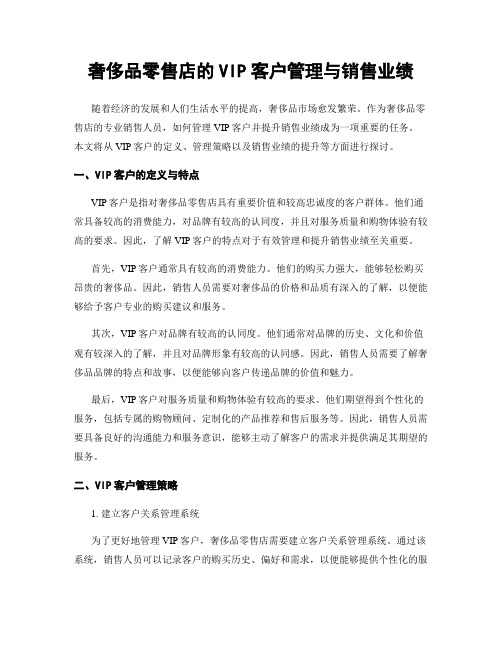
奢侈品零售店的VIP客户管理与销售业绩随着经济的发展和人们生活水平的提高,奢侈品市场愈发繁荣。
作为奢侈品零售店的专业销售人员,如何管理VIP客户并提升销售业绩成为一项重要的任务。
本文将从VIP客户的定义、管理策略以及销售业绩的提升等方面进行探讨。
一、VIP客户的定义与特点VIP客户是指对奢侈品零售店具有重要价值和较高忠诚度的客户群体。
他们通常具备较高的消费能力,对品牌有较高的认同度,并且对服务质量和购物体验有较高的要求。
因此,了解VIP客户的特点对于有效管理和提升销售业绩至关重要。
首先,VIP客户通常具有较高的消费能力。
他们的购买力强大,能够轻松购买昂贵的奢侈品。
因此,销售人员需要对奢侈品的价格和品质有深入的了解,以便能够给予客户专业的购买建议和服务。
其次,VIP客户对品牌有较高的认同度。
他们通常对品牌的历史、文化和价值观有较深入的了解,并且对品牌形象有较高的认同感。
因此,销售人员需要了解奢侈品品牌的特点和故事,以便能够向客户传递品牌的价值和魅力。
最后,VIP客户对服务质量和购物体验有较高的要求。
他们期望得到个性化的服务,包括专属的购物顾问、定制化的产品推荐和售后服务等。
因此,销售人员需要具备良好的沟通能力和服务意识,能够主动了解客户的需求并提供满足其期望的服务。
二、VIP客户管理策略1. 建立客户关系管理系统为了更好地管理VIP客户,奢侈品零售店需要建立客户关系管理系统。
通过该系统,销售人员可以记录客户的购买历史、偏好和需求,以便能够提供个性化的服务。
同时,该系统还可以帮助销售人员进行客户分类和分析,以便制定相应的销售策略。
2. 提供个性化的购物体验VIP客户对个性化的购物体验有较高的要求,因此销售人员需要根据客户的喜好和需求,提供专属的购物体验。
这包括为客户提供专属的购物顾问、定制化的产品推荐和购物环境等。
通过提供个性化的服务,可以增强客户的忠诚度和购买意愿。
3. 加强售后服务售后服务是保持VIP客户忠诚度的重要环节。
销售七步曲

销售七步曲:第一步:接近顾客目的:通过正确的打招呼和接近顾客,使顾客愿意停留在店里。
1、打招呼●表情(自信、微笑)●目光(亲切、柔和、眼神交流)●姿态(面对顾客、迎向顾客)●语言(亲切、自然)2、观察/接近顾客●时机:当顾客无明确目标、四处张望时当顾客停下、目光注视某件产品时当顾客用手触摸某件产品时当顾客与你目光相对时●机会:顾客没有清楚说出想要解决的问题,或减少不满的渴望。
●需要:顾客想要解决问题的愿望,会使用“需要言词”来表达自己的需要,如“我需要…”、“我正在找一个解决…的办法”、“我想要…”、“…对我很重要”、“我对…有兴趣”、“你这里是否有…”等…将“机会”转化为顾客的“需要”的言词:用“是不是”、“想不想”、“您是想看看/了解…吗?”等问句来转换第二步:发现并确定需要1、发现需要目的:通过正确询问,在最短的时间表内诱导顾客说出需要。
●赞美的目的:使人愉悦心情、拉近距离赞美要做到:真诚——发自内心,而不是奉承具体——赞美对方具体的事实赞美时——目光注视着顾客赞美时可以先观察顾客的外表、服饰、气质、皮肤、身材、鞋、包或任何其他值得赞美的地方●询问A、开放式——面对爱交谈的顾客,或你希望顾客畅所欲言时作用:收集顾客资料(顾客的情况、环境)、发掘需要、鼓励顾客详细说明他的需求。
举例:先生您好,请问我能帮到您吗?开放式询问言词:谁、什么、哪里、什么时候、为什么、如何B、限制式——面对沉默寡言的顾客,或你希望顾客回答“是”或“不是”,或根据范围作答。
作用:让回答限制于“是或否”、“在你提供的答案中做选择”“量化的事实”限制式询问言词:是不是、有没有、或是、哪一个举例:先生您是不是经常喝红酒?获得有关顾客情况、环境、需要的具体资料:您平时喜欢喝那种红酒?有没有兴趣尝试下我们意大利原装进口的**品牌的红酒。
澄清顾客所说的,建立正确的理解:“您的意思想找一款**口感的红酒,对吗?”“您的意思想找一款**价位的红酒,对吗?”帮顾客引导到需要的结论上:“改变…对您是否很重要?”——特别是顾客没有使用需要言词时。
第七章产品和服务
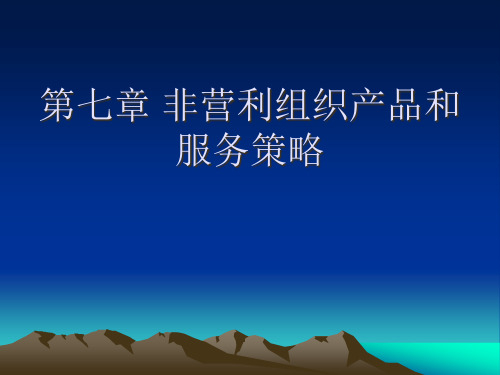
– ②消费者对这种产品不太了解,对价格又十分敏感;
– ③潜在的竞争比较激烈。
• 4.缓慢渗透策略:低价格、低促销
• 在新产品进入市场时采取低价格,同时不做大的促销努力。 低价格有助于市场快速的接受商品;低促销又能使企业减少 费用开支,降低成本,以弥补低价格造成的低利润或者使亏 损。适合这种策略的市场环境是:
价格竞争,价格不断被 迫下降。
二、产品生命周期各阶段策略
(一)产品导入期的营销策略 1.快速掠取策略:高价格高促销 2.缓慢掠取策略:高价格低促销 3.快速渗透策略:低价格高促销 4.缓慢渗透策略:低价格、低促销
高
缓慢掠取策略
价 格
缓慢渗透策略
快速掠取策略 快速渗透策略
低
促销
高
1.快速掠取策略:高价格高促销
– ③企业面临着潜在的竞争对手,想快速的建立良好的 品牌形象。
• 2.缓慢掠取策略:高价格低促销
• 在采用高价格的同时,只用很少的促销努力。高 价格的目的在于能够及时收回投资,获取利润; 低促销的方法可以减少销售成本。这种策略主要 适用于以下情况:
– ①商品的市场比较固定,明确;
– ②大部分潜在的消费者已经熟悉该产品,他们愿意出 高价购买;
指产品刚刚进入市场,处于向市场推广介绍的阶段。
1.产品刚进入市场试销,
尚未被市场顾客接受,
销售额增长缓慢。
金额
销售额曲线
2.生产批量小,试制费用
大,成本较高。
3.销售费用高。
利润曲线
4.一般没有同行竞争。
5.产品刚进入市场,由于
生产成本和销售费用较
时间
高,企业在财务上往往 是亏损的。
客户信用管理制度
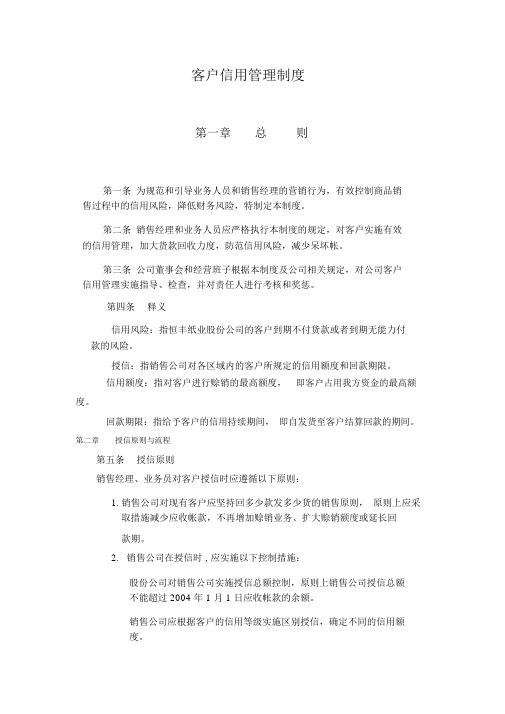
客户信用管理制度第一章总则第一条为规范和引导业务人员和销售经理的营销行为,有效控制商品销售过程中的信用风险,降低财务风险,特制定本制度。
第二条销售经理和业务人员应严格执行本制度的规定,对客户实施有效的信用管理,加大货款回收力度,防范信用风险,减少呆坏帐。
第三条公司董事会和经营班子根据本制度及公司相关规定,对公司客户信用管理实施指导、检查,并对责任人进行考核和奖惩。
第四条释义信用风险:指恒丰纸业股份公司的客户到期不付货款或者到期无能力付款的风险。
授信:指销售公司对各区域内的客户所规定的信用额度和回款期限。
信用额度:指对客户进行赊销的最高额度,即客户占用我方资金的最高额度。
回款期限:指给予客户的信用持续期间,即自发货至客户结算回款的期间。
第二章授信原则与流程第五条授信原则销售经理、业务员对客户授信时应遵循以下原则:1.销售公司对现有客户应坚持回多少款发多少货的销售原则,原则上应采取措施减少应收帐款,不再增加赊销业务、扩大赊销额度或延长回款期。
2.销售公司在授信时 , 应实施以下控制措施:股份公司对销售公司实施授信总额控制,原则上销售公司授信总额不能超过 2004 年 1 月 1 日应收帐款的余额。
销售公司应根据客户的信用等级实施区别授信,确定不同的信用额度。
在销售合同中注明客户的信用额度或客户占用我方资金的最高额度,但在执行过程中,应根据客户信用变化的情况,及时调整信用额度。
第六条授信流程销售公司销售经理或业务人员对客户授信时应遵守以下规程:第一步:客户资信调查第二步:客户信用等级评定第三步:根据客户信用等级确定其信用额度第四步:客户授信的执行和监督第五步:客户授信的检查与调整具体规程见附件一第三章客户资信调查第七条客户资信调查是指销售公司对客户的资质和信用状况所进行的调查。
第八条客户资信调查的要点客户资信调查的要点主要包括:1.客户基本信息;2.主要股东及法定代表人或主要负责人;3.主要往来结算银行帐户;4.企业基本经营状况;5.企业财务状况;6.恒丰纸业股份公司与该客户的业务往来情况;7.该客户的业务信用记录;8.其他需调查的事项。
销售时点信息系统OS

第七章销售时点信息系统(POS)在超级市场中,通用商品条码依赖于销售时点信息系统(Point of Sale,POS)来展示其优越性。
POS系统具有直接、及时入帐的实时处理能力,也就是说,在销售时,商品的各种信息数据是在交易的瞬间完成的。
因此,POS系统是一种全新的商业销售管理系统。
零售商要想在商战中获胜,不仅要靠商场的“软件”——改善销售环境,提高服务质量;更重要的是靠商场的“硬件”——管理设施的现代化,其中最主要的就是POS系统的建立以及POS系统和条码技术的完善结合,这些都能给商家带来可观的经济效益。
第一节 POS系统的组成与特点POS系统(Point of Sale,POS)即销售时点信息系统,最早应用于零售业,以后逐渐扩展到金融、旅馆等服务性行业,利用POS系统的范围也从企业内部扩展至整个供应链。
现代POS系统已不仅仅局限于电子收款技术,他要考虑将计算机网络、电子数据交换技术、条形码技术、电子监控技术、电子收款技术、电子信息处理技术、远程通信、电子广告、自动仓储配送技术、自动售货、备货技术等一系列科技手段融为一体,从而形成一个综合性的信息资源管理系统。
一、POS系统的组成POS系统包含前台POS系统和后台MIS系统两大基本部分。
在商场完善前台POS系统建立的同时,也应建立商场管理信息系统(Management Information System,简称MIS,实际是POS系统网络的后台管理部分)。
这样,在商品销售的任何过程中任一时刻,商品的经营决策者都可以通过MIS了解和掌握POS系统的经营情况,实现商场库存商品的动态管理,使商品的存储量保持在一个合理的水平,减少了不必要的库存。
1、前台POS系统前台POS系统是指通过自动读取设备(主要是扫描器),在销售商品时直接读取商品销售信息(如商品名称、单价、销售数量、销售时间、销售店铺、购买顾客等),实现前台销售业务的自动化,对商品交易进行实时服务和管理,并通过通信网络和计算机系统传送至后台,通过后台计算机系统(MIS)的计算、分析与汇总等掌握商品销售的各项信息,为企业管理者分析经营成果、制定经营方针提供依据,以提高经营效率的系统。
- 1、下载文档前请自行甄别文档内容的完整性,平台不提供额外的编辑、内容补充、找答案等附加服务。
- 2、"仅部分预览"的文档,不可在线预览部分如存在完整性等问题,可反馈申请退款(可完整预览的文档不适用该条件!)。
- 3、如文档侵犯您的权益,请联系客服反馈,我们会尽快为您处理(人工客服工作时间:9:00-18:30)。
授课技巧小提示
你注意到老师在授课过程中运用了哪些 方法?
课前回顾 讲述课程安排与计划 案例与活动 提问引导 组织讨论
第五部分:成交
总结一下你的产品或服务的好处,把顾客作 出的选择范围缩小,成交。
别等到顾客烦你的时候。 这有一个原则
如果顾客三次拒绝你,你还有一次机会; 如果他/她第四次拒绝你,那是真的不想买; 如果是这样,不失风度的认可,也许将来你会卖给
这位顾客一些商品呢。
第六部分:跟踪
定期跟踪调查,弄清楚顾客对你的产品 或服务的意见。
FAB运用
特点(F):产品与服务所具备的一切属性 作用(A):产品与服务为客户带来的帮助 利益(B):产品与服务对客户需求的满足
练习:洗衣机的这些参数带 给客户的利益是什么?
性能
作用
客户利益
全自动
45度的热水
6公斤容量
轻柔、正常 等洗涤模 式设置
重点观点:FAB(“特优列” 法则)+E(佐证)
问问是否需要你提供进一步的帮助。 如果顾客有怨言,别不理睬。 记住,最成功的买卖是建立在回头客基
础上的。
新世纪销售战略比拼——跟踪服务
电话回访 上门回访 网络回访 想一想:在我们的日常生活里,我们还可
以采取哪些方式来对我们的产品或服 务进行进一步的跟踪服务呢?
第七部分:请求推荐
对于需要你的产品或服务的顾客, 如果你的工作做得好,让他们把 你推荐个其他顾客。
你最初说的几句话很可能是最重要 的。
进行双向谈话,与顾客进行目光交 流,吸引他们的注意力。
第二部分:问候&了解需求
开场白 询问方式:
开场白
通过适当的问候语调节现场 的气氛,表现自身的礼貌。
专业的开场白:
没有进入正题不要介绍产品 第一次打电话,用“促销”等亮点来说 a.过两天来拜访,去之前再给电话 b.过两天再打电话,即使被拒绝,最后
营销心理学的运用
1.对比原理(以进为退)——讨论题: 应该先给顾客看价贵的货品还是便 宜货?
2.互惠原理 3.短缺原理 4.高价原理
*注:销售以客户需求为导 向,而不是以产品为导向
第四部分:处理反对意见
承认反对意见,作出处理。 不要假装你没听见,也不要有过激
反应,别害怕听。 一位著名的房地产商威廉·泽肯多夫
说,“听顾客讲话从不会让我的推 销损失一分钱。”
将托辞或异议转为机会 异议是顾客有兴趣的信号
活动1:小组模拟推销活动 “太贵了”——名牌运动鞋 “我想同商量一下”——香港三天游 “我得好好想一想”——人寿保险 “我们没有这笔预算”——洗衣干衣机 处理方法建议:微笑、同意、转移(引导)
托辞、再次提供产品或服务。
第三部分:产品展示或服务
让你的展示富有人情味。 指出它对于这位特殊顾客的好处。 合适的地方,运用道具和模型
(或实物)。
销售的本质:将产品性能变成顾 客利益
销售的本质,就是展示你的产品或 服务与众不同的性能,“如何”和 “为什么”能使客户受益(满足需 求),激发起并实现顾客的消费欲 望。
——教育潜在客户
第七课 销售
课程目标
销售拜访的七个步骤 通过引导、提问了解客户需
求 了解销售的本质:将产品性
能转变为消费者利益 应用销售心理学原理
课前预习:(我们要了解的)
销售拜访的七个步 骤:
– 准备 – 问候 – 展示产品或服务
– 处理异议 – 完成销售 – 跟进 – 请求推荐
销售过程的困难之处:
销售初期&结单阶段 陌生拜访&预约拜访
第一部分:准备
在思想上做好准备。
想想你的产品或服务能给这位顾客带 来什么好处。都能够脱口而出。
如果顾客想深入了解,你也要乐于满 足他们。
思考讨论:
我的公文包会是什么样子 的?
里面要装些什么呢?
我的公文包:
名片,
佐证(强调优势 与价值),
白纸,笔,计算 器等办公用品,
个人用品,
拜访计划表, 零钱, 地图, 促销品
……
佐证:
获奖证明。 佐证产品的效果和带给客户的价值。 佐证多样更可信。
小组讨论:
对于佐证,请举一些适当的例子。 请讨论佐证的作用。
第二部分:问候&了解需求
很体面地向顾客问好,不要立即进 入有关生意的话题。
也能打动人家
这时我们可以运用地方法:
自我介绍-----握手礼仪 -----名片的递交
拜访目的 能为对方带来的利益 时间 征求意见
询问方式:
封闭式问题 开放式问题
询问的目的:
医生如何判断? 医生的目的是什么?
为什么牙买加车祸特别多?
为什么牙买加车祸特别多?
为什么牙买加车祸特别多?
? 询问目的:
了解更多的信息 提练信息,分析顾客有什么需求? 判断是否是你的准客户? 对症下什么药?
了解顾客的需求
隐藏性需求——以问题点作为叙述需求; 尽快引导到明显性需求,隐性需求别急 于出招。当客户和销售人员都不确定有 问题时,都归为隐性需求。
明显性需求——以明确的需求或期望作 为陈述的一种需求,是能带来实质性销 售的。
